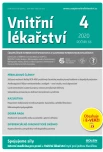Liver fibrosis
Authors:
Václav Šmíd
Authors‘ workplace:
IV. interní klinika – klinika gastroenterologie a hepatologie 1. LF UK a VFN Praha
Published in:
Vnitř Lék 2020; 66(4): 61-66
Category:
Overview
Liver fibrosis is the excessive deposition of extracellular matrix in liver tissue resulting in structural and functional liver changes. The basis for these changes is the imbalance between fibrogenesis and fibrolysis, which arises in response to chronic liver damage, regardless of its aetiology. Advanced liver fibrosis leads to cirrhosis with its possible complications – portal hypertension, hepatocellular carcinoma, and liver failure. For patients with chronic liver disease, the development of liver fibrosis as well as its severity is the most important prognostic factor. Early diagnosis is a key to avoid above mentioned complications. Understanding the molecular mechanisms underlying liver fibrogenesis is fundamentally relevant to developing new antifibrotic treatments that are independent of the underlying aetiology.
Keywords:
extracellular matrix – diagnosis of liver fibrosis – hepatic stellate cells – liver fibrosis – therapy of liver fibrosis
Sources
1. Wynn TA. Cellular and molecular mechanisms of fibrosis. J Pathol 2008; 214 : 199–210.
2. Bataller R, Brenner DA. Liver fibrosis. J Clin Invest 2005; 115 : 209–218.
3. Friedman SL. Liver fibrosis - from bench to bedside. J Hepatol 2003; 38: (Suppl. 1): S38-S53.
4. van der Meer AJ, et al. Reliable prediction of clinical outcome in patients with chronic HCV infection and compensated advanced hepatic fibrosis: a validated model using objective and readily available clinical parameters. Gut 2015; 64 : 322–331.
5. Tsochatzis EA, Bosch J, Burroughs AK. Liver cirrhosis. Lancet 2014; 383 : 1749–1761.
6. De Leeuw AM, Brouwer A, Knook DL. Sinusoidal endothelial cells of the liver: fine structure and function in relation to age. J Electron Microsc Tech 1990; 14 : 218–236.
7. Geerts A. History, heterogeneity, developmental biology, and functions of quiescent hepatic stellate cells. Semin Liver Dis 2001; 21 : 311–335.
8. Lee UE, Friedman SL. Mechanisms of hepatic fibrogenesis. Best Pract Res Clin Gastroenterol 2011; 25 : 195–206.
9. Canbay A, et al. Apoptotic body engulfment by a human stellate cell line is profibrogenic. Lab Invest 2003; 83 : 655–663.
10. Kocabayoglu P, Friedman SL. Cellular basis of hepatic fibrosis and its role in inflammation and cancer. Front Biosci (Schol Ed) 2013; 5 : 217–230.
11. Schuppan D, et al. Matrix as a modulator of hepatic fibrogenesis. Semin Liver Dis 2001; 21 : 351–372.
12. Trautwein C, et al. Hepatic fibrosis: Concept to treatment. J Hepatol 2015; 62: (1 Suppl.): S15-S24.
13. Sumida Y, Nakajima A, Itoh Y. Limitations of liver biopsy and non‑invasive diagnostic tests for the diagnosis of nonalcoholic fatty liver disease/nonalcoholic steatohepatitis. World J Gastroenterol 2014; 20 : 475–485.
14. Kleiner DE, et al. Design and validation of a histological scoring system for nonalcoholic fatty liver disease. Hepatology 2005; 41 : 1313–1321.
15. Stasi C, Milani S. Non‑invasive assessment of liver fibrosis: Between prediction/prevention of outcomes and cost‑effectiveness. World J Gastroenterol 2016; 22 : 1711–1720.
16. Angulo P, et al. Independent predictors of liver fibrosis in patients with nonalcoholic steatohepatitis. Hepatology 1999; 30 : 1356–1362.
17. Wai CT, et al. A simple noninvasive index can predict both significant fibrosis and cirrhosis in patients with chronic hepatitis C. Hepatology 2003; 38 : 518–526.
18. Vallet‑Pichard A, et al. FIB-4: an inexpensive and accurate marker of fibrosis in HCV infection. Comparison with liver biopsy and fibrotest. Hepatology 2007; 46 : 32–36.
19. Angulo P, et al. The NAFLD fibrosis score: a noninvasive system that identifies liver fibrosis in patients with NAFLD. Hepatology 2007; 45 : 846–854.
20. Guechot J, et al. Automation of the Hepascore and validation as a biochemical index of liver fibrosis in patients with chronic hepatitis C from the ANRS HC EP 23 Fibrostar cohort. Clin Chim Acta 2010; 411 : 86–91.
21. Guha IN, et al. Noninvasive markers of fibrosis in nonalcoholic fatty liver disease: Validating the European Liver Fibrosis Panel and exploring simple markers. Hepatology 2008; 47 : 455–460.
22. Bansal MB, Chamroonkul N. Antifibrotics in liver disease: are we getting closer to clinical use? Hepatol Int 2018; in press; online https://doi.org/10.1007/s12072–018–9897–3.
23. Cohen‑Naftaly M, Friedman SL. Current status of novel antifibrotic therapies in patients with chronic liver disease. Therap Adv Gastroenterol 2011; 4 : 391–417.
24. Marcellin P, et al. Regression of cirrhosis during treatment with tenofovir disoproxil fumarate for chronic hepatitis B: a 5-year open‑label follow‑up study. Lancet 2013; 381 : 468–475.
25. Romero‑Gomez M, Zelber‑Sagi S, Trenell M. Treatment of NAFLD with diet, physical activity and exercise. J Hepatol 2017; 67 : 829–846.
26. Schuppan D, Kim YO. Evolving therapies for liver fibrosis. J Clin Invest 2013; 123 : 1887–1901.
Labels
Diabetology Endocrinology Internal medicineArticle was published in
Internal Medicine

2020 Issue 4
Most read in this issue
- Liver fibrosis
- Evaluation of surgical risk in patients with liver cirrhosis
- Microscopic polyangiitis
- Hyperuricemia in renal disease patients
